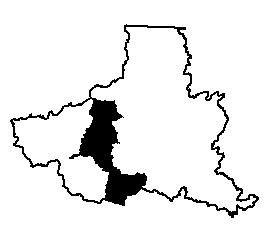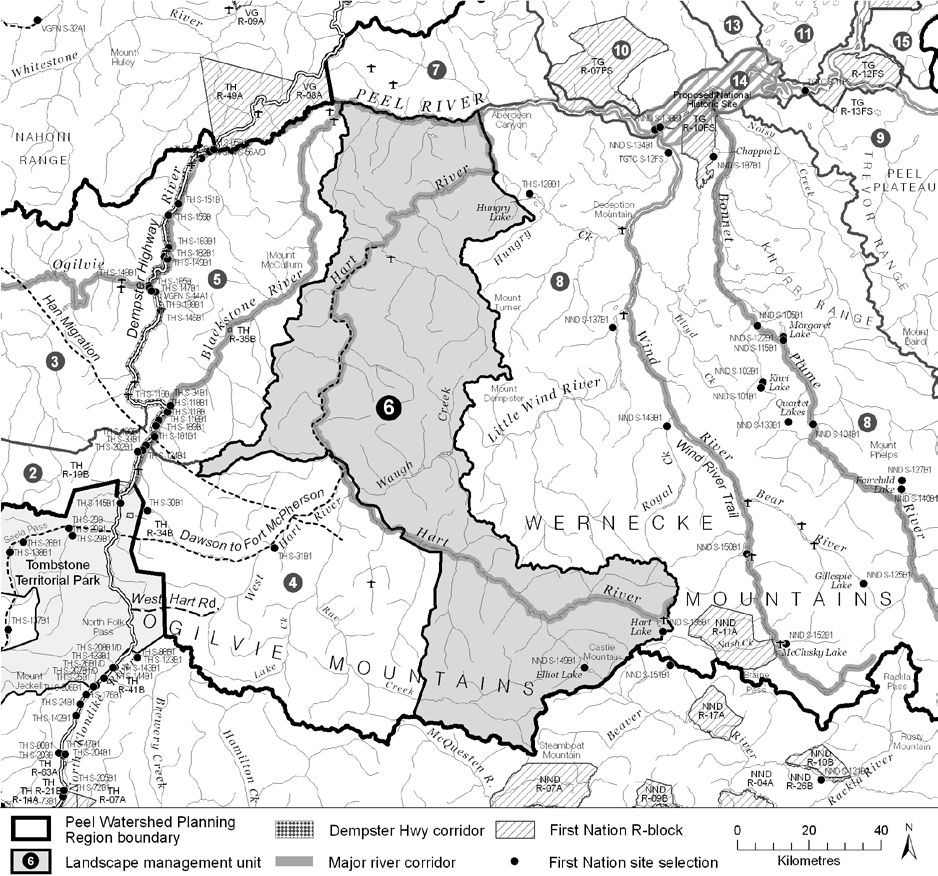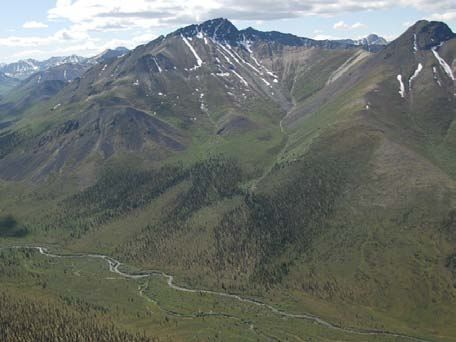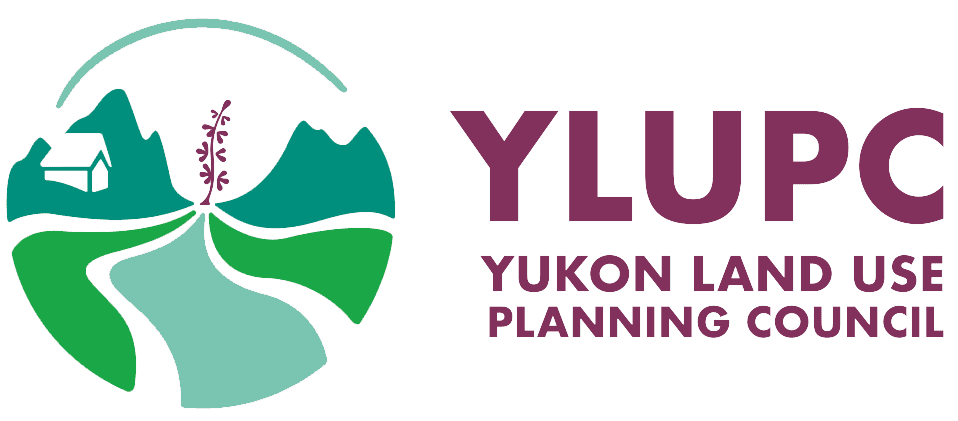PEEL WATERSHED PLANNING REGION:
LMU 6: Hart River
Land Use Designation
Wilderness Area
Land Status
Non-Settlement Land, NND Settlement Land (S-135B, S-149B)
Traditional Territories
Tr’ondëk Hwëch’in, Na-Cho Nyäk Dun, Vuntut Gwitchin, Tetłit Gwich’in Primary and Secondary Use Area
Area
8,304 km2 (12% of Region)


Objectives
- Wilderness character is maintained.
- First Nations’ cultural activities are practiced without significant disturbance from other land-use activities.
- Unfettered movement and habitat use of Porcupine and Hart River caribou herds, Dall’s sheep and other large mammals.
- Wilderness tourism and outfitting activities that are consistent with the objectives above.
Rationale for Designation
- Extensive habitat and key areas for the Hart River herd which is of the Northern Mountain ecotype, listed as “Special Concern” under SARA.
- Extensive general winter and fall use areas for the Porcupine caribou herd.
- Extensive sheep habitat valued by outfitters and the TH.
- Provided connectivity between Tombstone Territorial Park and LMU 4 to the west, and LMU 8 to the east.
- Generally high ecological values, no coal, oil and gas potential, and generally low potential for carbonate hosted zinc-lead and Wernecke Breccias.
Implementation News
- A hydrometric station has been established or reactivated at Hart River near Hungry Lake.
Cumulative Effects Thresholds
Relative to LMU Size*
Surface Disturbance (%)
Linear Density (km/km2)
Current disturbance (2020)
0.0136
0.0170
Cautionary
0
0
Critical
0
0
On the ground amounts**
Surface Disturbance (km2)
Linear Disturbance (km)
Current disturbance (2020)
1.13
141.5
Room under cautionary threshold***
0
0
Cautionary
0
0
Critical
0
0
*These are proportional to the size of the LMU, and correspond to table 3-2 of the Approved Plan. They are measured in the % of the LMU that can be disturbed (“Surface Disturbance”) and in km/km2 (“Linear Disturbance Density”).
**These are amounts that can be measured and apply to the whole LMU and would be more familiar to project proponents and regulators. They are measured in km2 of disturbance and in km of linear disturbance (e.g., roads, trails and cutlines).
***How much more disturbance can be added to existing disturbance before the cautionary threshold is reached.
Amount of disturbance relative to the cautionary theshold:
%
Surface Disturbance
%
Linear Disturbance
Biophysical Setting
Setting
A large mountainous watershed punctuated with bands of flatter, forested terrain
Ecoregions
Mackenzie Mountains, North Ogilvie Mountains, transition to Eagle Plains
Bioclimatic Zones
Taiga Wooded, Taiga Shrub and Alpine (minor Boreal)
Image Explanation
Gentle mountains separated by often broad valleys characterize LMU 6. (CWS photo)

Ecological Resources
Caribou
High value winter habitat of the Hart River herd concentrated along forested valley bottoms and flatter terrain. Moderate value winter habitat of the Porcupine herd throughout. Both herds have extensive key/general use winter and fall areas scattered throughout this unit.
Moose
Broad swathes of high habitat suitability and use in valley bottoms, and in narrow bands along smaller tributaries; low-nil late winter habitat suitability in higher country.
Marten
In headwaters, the high value winter habitat is in valley-bottom forests. Moderate-high quality habitat gets more extensive down towards the Peel River.
Sheep
Extensive areas of highly suitable winter habitat with documented (TK, big game outfitters, scientific) habitat use. Scattered licks and movement corridor(s).
Fish
Scattered known fish occupancy sites, fish presence likely in rivers, lower gradient tributaries. Little fish data for this area.
Grizzly Bear
Mostly moderate habitat suitability in low to mid elevations, high in riparian areas.
Peregrine Falcon
High potential for peregrine falcon foraging and nesting along lower Hart River and Peel River.
Birds (General)
High value waterbird habitat in riparian areas; low breeding birds species richness, high in riparian areas; high number species of conservation concern.
Vegetation
Moderate-high endemism/rarity along upper Rae Creek and below West Hart River. Low-mid elevation wet/dry shrub, subalpine shrub, and alpine exposed rock.
Wetlands, Lakes and Riparian Areas
Large wetland complexes on Hart River, scattered wetlands. Three sizeable lakes in headwaters (Worm, Elliot, and Hart Lakes).
Permafrost
Continuous permafrost is predicted.
Special Features
Several mineral licks; several possible wildlife passes.
Heritage, Social and Cultural Resources
Heritage Resources
Numerous travel routes connecting to Blackstone River, to Dempster Hwy/Tombstone (via West Hart River), to Little Wind River (via Waugh Creek), to Wind River (via Hungry Lakes) and through Rae Creek. Several cabins (TH, NND).
Palaeontological Resources
Sedimentary rocks in this area have high potential to yield Paleozoic fossils.
Economic Development
Transportation and Access
Few old winter roads in the lower section of unit; a conceptual access route has been identified in this unit between Waugh Creek to West Hart/Dempster Hwy. Three airstrips. Floatplane landing at three lakes.
Traditional Economy
TH traditional harvesting and wildlife areas and TG seasonal land use; TH fish harvesting.
Recreation and Tourism
Very high values for wilderness paddling. Extensive wilderness hiking in the headwaters of West Hart and Hart Rivers. Road access to West Hart, Fly-in put-in access in upper Hart River (Hart Lake, Elliot Lake and Worm lake); horseback touring.
Forestry
Little potential for forestry.
Big Game Outfitters and Trapping
Blackstone Outfitting Ltd. and Midnight Sun Outfitting Ltd.; high value hunting.
Oil and Gas Resources
No potential.
Mineral Resources
Approximately 427 (2023, 950 in 2011) quartz claims and no proven deposits; low copper/gold/uranium potential; moderate zinc-lead potential; moderate-high general potential.
Special Management Considerations
- The administrative boundary between NND and TH traditional territories runs through the central-west part of the unit.
